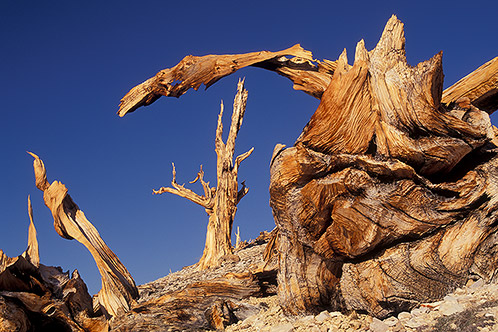Bristlecone Pines, Sculptures of Time
(Click image to enlarge)
The trees in this photograph have died, perhaps thousands of years ago. This specie of bristlecone pine, the Pinus longaeva, is among the longest living life forms on Earth. Some are known to live nearly 5,000 years, having sprouted before the Egyptian pyramids were built and just as the stone age was ending. When these trees die they often remain standing on their roots for many centuries. Fallen trees and dead wood, like that in the foreground, lasts thousands of years longer. That's long enough for wind blown abrasive materials and weather to erode the surface of the wood, polishing it into smooth and fantastically sculpted forms. They are truly sculptures of time.
Although the trees in this photograph are dead, many living trees look nearly the same. They might have only one small living branch with green needles and a thin strip of bark on one side bringing moisture and nutrients to it. Bristlecone pines have the unique ability to survive harsh conditions by allowing parts of the themselves to die so other parts can survive. The older a tree gets, and the more adversity it endures, the more of it is dead wood. So far it seems to be a successful strategy, though climate change and disease is now taking a toll on these ancient trees. Specifically, White pine blister rust is a lethal, nonnative disease of white pines that also infects the ancient bristlecone pines. It was introduced to North America from Asia, via Europe, in the early 20th century. It was first discovered in Colorado in 1998 and has since slowly spread through the continent. This 20th century human phenomena will end the story of these millennia old trees in what, relatively speaking, is the blink of an eye.
Tree rings from both living and dead trees give us a tree ring history that goes back nearly 10,000 years. By radioactive carbon dating the ring samples, which have definitely known ages, it was found that the amount of radioactive carbon in the atmosphere varied over time. That in turn allowed calibration of the radioactive carbon dating process, making it much more accurate. All living things absorb radioactive carbon while they are alive and stop doing so after death. At that point the radioactive carbon decays at a very exact rate, allowing us to determine how long ago the once living material died. In order for that process to be precise, the initial amount of radioactive carbon must be known. We used to think it was constant over large spans of time, but these trees taught us that it was not.
Because these bristlecone pines do not compete well with other plants and trees, they are typically found in conditions that are too harsh for most other plants to survive. High altitudes, poor soils, and little moisture make the ideal environment for these trees. The trees in this photograph were found at an altitude of about 11,200 feet (3413 M) in soil composed mostly of rocks, in an area that receives almost no rain.
